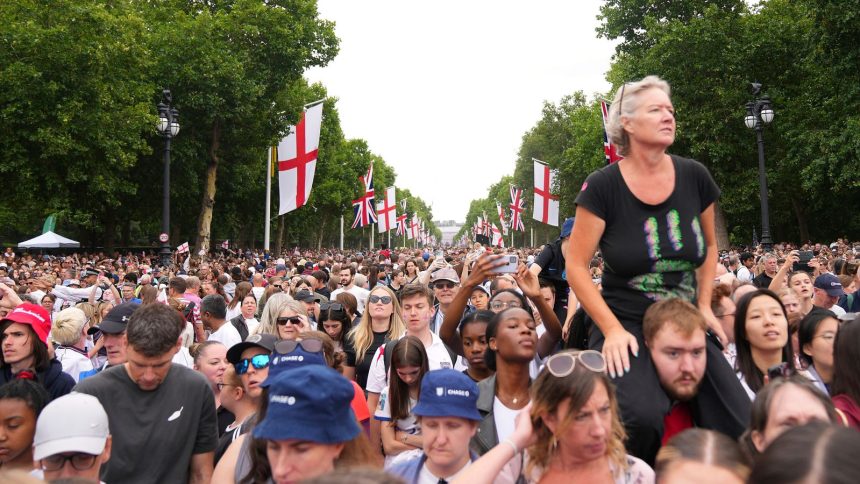As the Lionesses’ victory bus made its way from The Mall to the iconic Buckingham Palace forecourt, the clouds parted, bathing the gathering crowd in sunlight. The atmosphere was electric, with far more than the anticipated 50,000 fans pouring in to celebrate the team’s recent triumph. Men, women, children, and even grandparents filled the space, showcasing a diverse fan base that challenges the outdated stereotype of who supports women’s football.
The conclusion of this parade, honoring a second consecutive European Championship win, felt particularly special. Many fans, who had traveled to London early Tuesday, were eager to witness their heroes in person, even as some went to great lengths to secure the best possible view. Promotions warning of overcrowding were met with determination, as fans climbed any available structure to catch a glimpse of England’s stars. One family shared that they had arrived at 1 a.m. to claim their prime spot along the famed procession route.
“She’s been inspired to play football by the Lionesses,” relayed a grandparent about their granddaughter, who proudly wore an England shirt bearing Alessia Russo’s name and number. While calling the England Women’s team inspirational might seem cliché, moments like these underline the profound impact they have.
Just three years ago, only 7,000 fans filled Trafalgar Square for the 2022 European Championships. Now, the scale of these celebrations would necessitate closing central London if held in the same location.
The rise of women’s football in England can be attributed to several factors, including the establishment of the Women’s Super League (WSL), full-time contracts, and increased media coverage. But the influence of the Lionesses remains paramount. Even after the parade concluded, fans lingered, captivated as players took photographs with their loved ones on stage.
Another family present at the event praised their 14-year-old daughter’s shift in club allegiance inspired by captain Leah Williamson’s leadership. “I play as a striker but I love the way Leah manages the team on and off the field,” Evie said.
Williamson exemplifies leadership, echoing the dedication of head coach Sarina Wiegman, who has been instrumental since day one. Despite being a history-maker herself, she consistently redirects praise towards her players and support staff. Following last Sunday’s final, Wiegman was quick to celebrate her squad’s success when asked about securing her third consecutive European Championship title.
The day took an even more extraordinary turn when Burna Boy, Wiegman’s favorite artist, joined her for a duet. Celebrating at Buckingham Palace as the sun illuminated the scene felt surreal, even for the seasoned coach. “I would say it is a dream come true, but you can’t dream of this,” she told Sky Sports. “It was totally impossible in an earlier life and then you are here at Buckingham Palace on a bus with everyone waving and partying. I will never forget this in my life.”
For Wiegman and her players, the journey of the women’s game is still ongoing. Reflecting on the growth since the last Euros held in England in 2005, it’s important to recognize how far the sport has come. Back then, the Lionesses’ performances were overshadowed by their commitments outside of football. Now, even players like Michelle Agyemang, who has only recently joined, are celebrated upon returning home to chants from thousands of fans.
However, concerns about the longevity of the Lionesses’ legacy have emerged, particularly regarding financial stability and societal support following the initial wave of enthusiasm catalyzed by the 2022 tournament. Yet, the overwhelming turnout at the parade serves as a testament to the enduring interest in women’s football, raising the question of what the crowds will look like in 2029.














